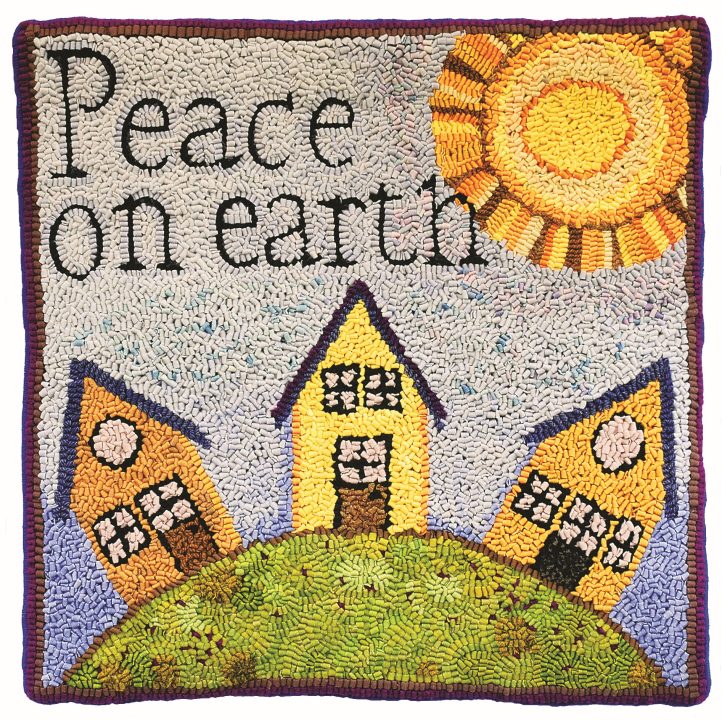
Peace on earth, 24″ x 24″, #8-cut wool and pantyhose on linen. Designed and hooked by Michelle Sirois-Silver, Vancouver, Canada, 2010.
BY MICHELLE SIROIS-SILVER PHOTOGRAPHY BY ANDREA SIROIS
Peace on earth is a whimsical design hand hooked using basic directional and random hooking techniques and introducing pantyhose as a material for hooking text and outlining. Hook this lighthearted design with a playful tone as you explore different ways to hook.
MATERIALS
These estimates are based on a #8 cut and a 6:1 ratio. A 6:1 ratio means that for every square foot of hooked surface area you will need approximately six square feet of fabric. The rug was hooked with wool fabric, with the exception of the text and some outlines, which were hooked with pantyhose.
- Border: Black, 6″ x 24″
- Words: 1 pair black pantyhose, 1 pair of gray pantyhose
- Sun: Range of 6 yellows and oranges in light to mid-light values, 24″ x 24″ total
- Earth: Range of 3 yellow-greens in mid-light to mid values, 24″ x 24″ total
- Houses: Range of yellow-greens, yellow-oranges, blue-violets, and red-violets in varying amounts. Use leftover strips from the sun and the earth and a grayed blue-violet to fill the windows. Use leftover strips from the letters to outline the windows and doors.
- Sky: Range of 3 blue-violets in mid-light to mid values, 36″ x 36″ total.
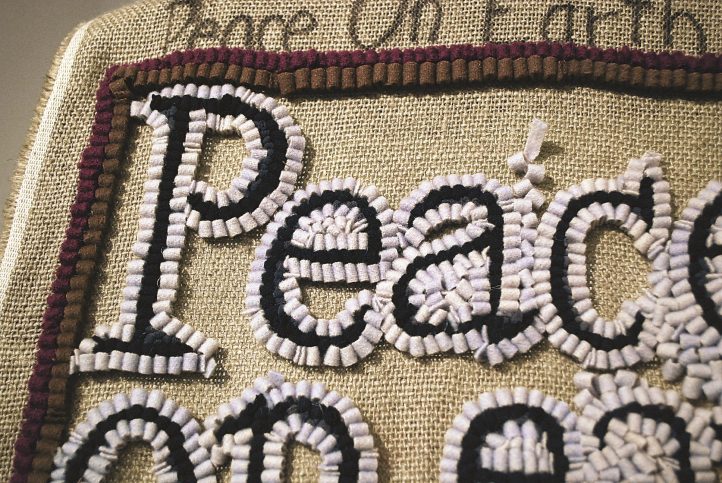
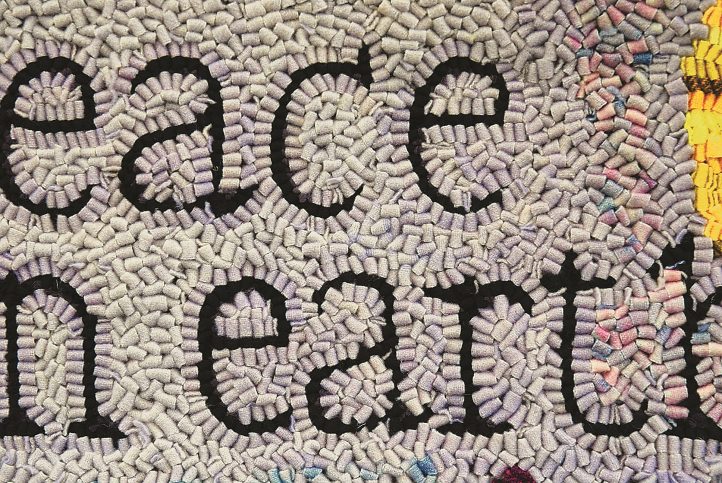
The letters are hooked with pantyhose, then outlined with #8-cut wool strips.
DIRECTIONAL AND RANDOM HOOKING
Both directional and random hooking should be used when designing a rug. Each has its specific uses.
Directional hooking forms a continuous line of loops hooked in straight or curved rows and is used to outline elements to help them hold their shape. It can also be used to fill elements, hook backgrounds, and create text. It can direct the eye from one area of a design to another and can create a sense of motion or tension. For an example of directional hooking, note how the crescent shape of the earth is outlined with a directional line to separate and define its shape. The curved directional loops in the fill form a series of amoeba-like shapes that create visual contrast and interest.
Random hooking involves forming alternating twists on loops and following a zig-zag path to create the appearance of randomness. I love using this hooking technique to create texture and to seamlessly blend colors and values. The center of the sun is an example of random hooking that demonstrates how it is used to blend the different yellow-oranges.
Learning to random hook takes a little practice but the results are worth the effort. For this technique, the first loop pulled to the top of the backing is twisted with the hook to a 2 o’clock position. The next loop is pulled up and twisted to 4 o’clock. The alternating 2 and 4 o’clock twists are repeated until the area is filled or the outline is completed. And the loops are not hooked in a single row but rather in a zig-zag pattern, back and forth across two or three rows of backing, allowing for the adjacent rows to be hooked in between the openings thus created.
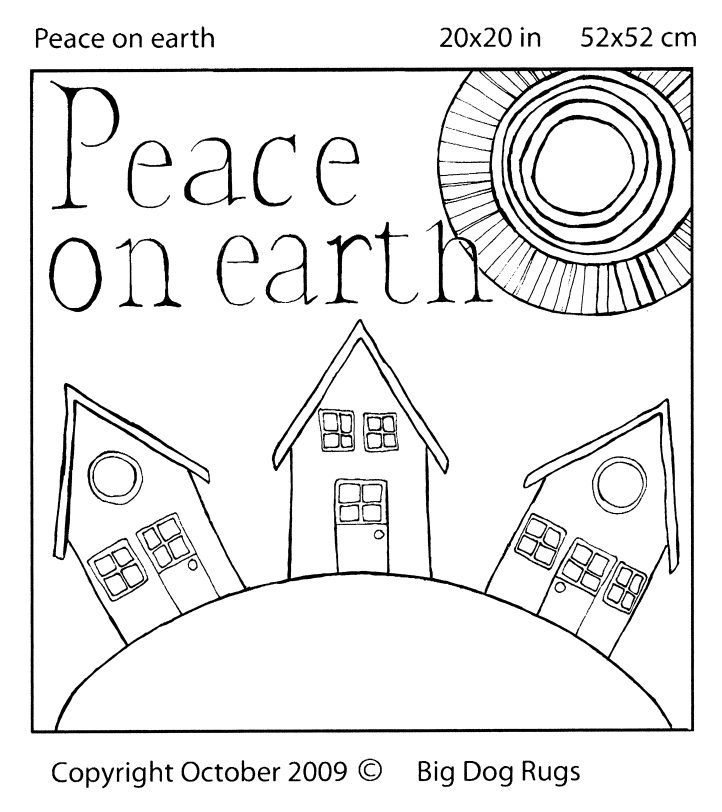
Peace on earth, 24″ x 24″. Enlarge this pattern to the size you prefer. 20″ x 20″ or 24″ x 20″ work well. Copyright October 2009 Big Dog Rugs. This pattern is for one-time personal use only. Reselling of the pattern is prohibited.
Color is another important design element in this rug. I chose a yellow-orange sun as the starting point for my color plan. Because my design has diverse elements, including sky and earth, I used my color wheel to select two pairs of complementary colors: yellow-orange and blue-violet, and yellow-green and red-violet. The sky is blue-violet, the earth is yellow-green, and the houses are combinations of yellow-orange, blue-violet, and red-violet. The complementary color pairs create wonderful opportunities for light/dark and warm/cool contrasts. I chose a palette of mid- to light values with a few darks thrown in to create dynamic contrast. I hooked the text using black and grey pantyhose.(If you are interested in learning more about color, I suggest Betty Krull’s The Secrets of Color in Hand-Hooked Rugs.)
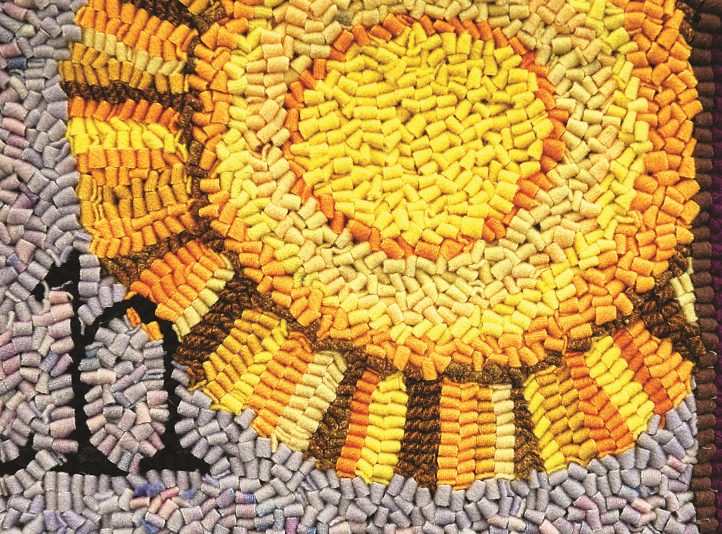
The center of the sun is hand hooked with random loops; the radiating lines are hooked with directional lines.
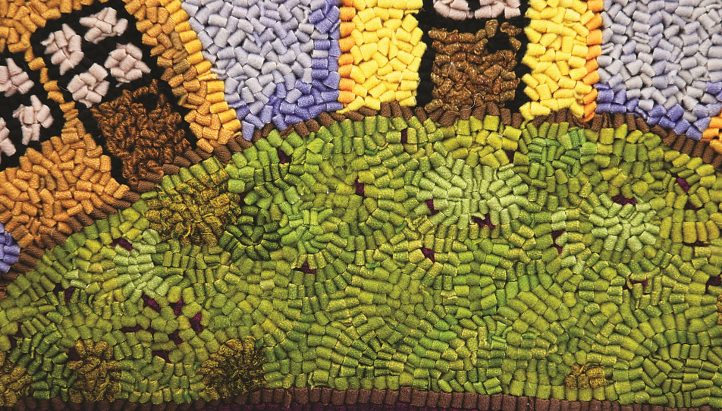
Directional lines hooked in a variety of directions fill the earth.
HOOKING WITH HOSE
Pantyhose are perfect for outlining design elements and creating text because they are opaque, hold their shape, and crisply define letters. For Peace on earth, I outlined the windows and doors and created the text using pantyhose. For the text I hooked a continuous directional line for each letter with black pantyhose and then used gray pantyhose to add highlights to the text. When I hooked the background I started by outlining the letters, then filled them in.
I initially planned to combine both #8 and #4 cuts, using the narrow widths to hook details. For example, I planned to use the #4 cut in the sun, where the light radiates in lines from the inner circles, but I soon realized that #8 cuts would give me the color blocking that I was looking for. Be sure to try different cut sizes in your work.
HOOKING DIRECTIONS
Begin with the border. Before hooking the design elements in this piece, hook one or two rows along the outside edge of the pattern to create your border.
Hook the words. The letters are the first design element to be hooked because they overlap the edge of the sun.
- To prepare the pantyhose, use a rotary cutter and a healing mat or a pair of scissors to cut 1/2″-wide strips across the leg. Pull the strips to form tubes and snip each tube to create lengths. Prepare both black and gray pantyhose.
- Hook the letters with the black pantyhose. Tip: Pull the loops for the letters slightly higher than the background to ensure that the letters do not disappear when the background is hooked beside them.
- Highlight the letters with the gray pantyhose.
- Using a directional line, outline the letters with blue-violet.
Hook the sun. The sun is hooked in a range of yellows and yellow-oranges.
- Begin with the center circle. Outline this circle using a random outline and then fill it with random hooking.
- Continue hooking the remaining rings using the same steps.
- Use directional hooking for the lines radiating out from the sun.
Hook the earth. The amoeba-like shapes hooked with a range of yellow-greens lend interest and a sense of motion.
- Use a directional line to outline the earth and to define and hold its shape.
- Draw amoeba-like shapes directly onto the backing with a permanent marker. The shapes should be approximately 1″ diameter.
- Outline and then fill each amoeba with directional hooking.
Hook the houses. I used combinations of yellow-orange, yellow-greens, blue-violets, and red-violets. The windows and doors are outlined with black pantyhose. Make your houses unique by selecting your own combinations of colors.
- Use directional hooking for the roof lines.
- Use directional hooking to outline the windows and doors using leftover pantyhose prepared for the text.
- Use random hooking to fill the windows and doors.
- Use directional hooking to outline the houses and then fill them with random hooking.
Finish with the sky. I used three values for the sky: light blue-violet, light blue, and medium blue-violet. Tip: Note how using the medium blue along the sides of the houses closest to the border creates a sense of depth.
- Use random hooking for the sky and start by filling the letters o, e, a, and P.
- Continue random hooking to outline and fill the rest of the sky.
